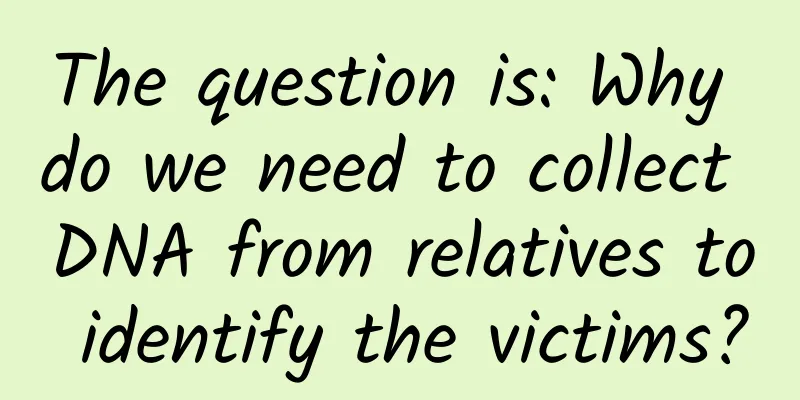The question is: Why do we need to collect DNA from relatives to identify the victims?

|
Expert of this article: Zhang Yinming, PhD in Forensic Medicine, Xi’an Jiaotong University More than a week has passed since the MU5735 air crash. At around 9 am yesterday (March 28), the identity of the last passenger was determined. The DNA matching of the 132 victims was completed and their identities were all confirmed. Weibo screenshot According to reports, after the accident, a 30-member expert group from the Ministry of Public Security's Forensic Identification Center and more than 200 public security criminal technicians from Guangxi jointly completed the DNA comparison of 132 people on board and their relatives. How was the DNA comparison of the victims completed? How difficult was it? Why was the DNA of the family members collected? Let's find out. What is DNA matching? The purpose of discovering and extracting biological samples at the air crash site is, firstly, to clarify the distribution of the remains, which will help analyze the cause of the air crash; secondly, to identify the identities of the people in the air crash and solve the problem of the ownership of the remains. The remains at the scene of an air crash are often fragmented and incomplete, and there may be a mixture of remains of multiple people. It is necessary to test the biological markers of the remains and compare them with reference samples to ultimately determine the identity of the remains. On March 28, search personnel worked at the accident site. Photo by Xinhua News Agency reporter Huang Xiaobang At air crash sites, especially those in tropical and subtropical areas, biological markers in the remains are often easily contaminated or degraded by environmental influences. Therefore, scholars such as Zietkiewicz believe that traditional forensic anthropology and physiological characteristics (such as teeth, skin, hair, fingerprints, etc.) can only provide reference opinions, and DNA typing technology is the gold standard for individual identification. The principle of this process is consistent with forensic individual identification and paternity testing. By comparing the DNA of the remains with the DNA of the reference sample, if enough genetic markers are detected and the DNA of the remains is consistent with the reference DNA, it can be determined that the remains and the reference DNA are from the same individual; or if the DNA of the remains and the reference sample DNA have a certain kinship relationship, it can be determined that the remains are from a relative of the reference DNA. Copyright image, no permission to reprint Among many DNA genetic markers, short tandem repeats (STR) sequences have the characteristics of high sensitivity, high identification ability, and easy standardized typing. They are currently the mainstream technology in the field of forensic evidence identification. Application scenarios of DNA comparison Earthquakes (such as the Wenchuan earthquake, the 3.11 earthquake in Japan, etc.), tsunamis (such as the 2004 Indian Ocean tsunami), plane crashes, fires, terrorist attacks (such as the 9.11 incident, etc.) How difficult is DNA matching? The remains at the crash site have several notable features: The remains are in varying conditions and are incomplete: huge violent impacts can destroy the human body and even break it into tissue fragments that are scattered everywhere, increasing the difficulty of searching; if there is a fire, the remains may be charred, affecting subsequent laboratory tests. The remains are greatly affected by the environment: the influence of soil microorganisms, environmental temperature and humidity in tropical regions will accelerate the decay of biological samples and the degradation of DNA. Large pieces of remains may be eaten by animals or insects. Potential contamination of samples: After an incident, the most urgent task is to search for survivors. At a scene where people gather, contamination between the remains and the surrounding soil or between the remains is inevitable. Source: CCTV News DNA will also be affected by the above factors. The longer the time and the higher the ambient temperature, the more serious the DNA degradation, the more genetic markers need to be tested, and the lower the success rate of the comparison. Faced with this difficult problem, what do forensic scientists do? In actual work, forensic scientists need to collect as many remains samples as possible at the crash site and preserve them properly, and also need to compare the DNA typing results of the remains with reference samples in the laboratory. The samples collected include biological samples of the victims' remains, samples taken before death, and samples of the victims' relatives for kinship analysis. Samples taken by the victims before their death can be used for direct comparison, mainly including: personal belongings used by the victims, such as toothbrushes, combs, razors, etc.; biological samples left behind before their death, such as bloodstains, tissue sections, pulled out or fallen teeth, etc. Some netizens said in the news that the accident handling agency extracted blood from the passenger's mother's fingertips as a relative DNA sample, but such samples can only be used to analyze the relationship between relatives and victims. Different DNA genetic markers need to be selected according to the relationship. Some common relatives include: Both parents or one parent child Brothers, sisters and other immediate family members Other distant relatives Copyright image, no permission to reprint We still don’t know what specific problems forensic scientists have solved, but we can get a feel for it by looking back at the investigation of Swissair Flight 111. "On September 2, 1998, Swissair Flight 111 crashed, killing all 229 passengers, including 15 crew members. More than 2,400 remains were found at the crash site, of which 1,277 were used for DNA analysis, and 310 samples of relatives were extracted. ... 4-9 STR loci were selected for DNA analysis, and the number of genotype cross-matches exceeded 180,000 times. ..." At present, there are at least 15-20 STR loci used in forensic practice in my country, which improves the accuracy of comparison while also greatly increasing the number of comparisons required; for complex kinship relationships (such as grandparents and grandchildren, half-siblings, etc.), it is also necessary to select appropriate DNA genetic markers (such as Y chromosomes, mitochondria, etc.) according to the specific type of kinship; and the pretreatment of samples with varying degrees of degradation and contamination has undoubtedly greatly increased the difficulty of the work of forensic scientists in air crash investigations. DNA matching plays a very important role in accidents and is also an important part of the accident investigation process. Due to the influence of many factors such as the environment, the work of experts can be easy or difficult, but the ultimate goal is to get accurate results as soon as possible. The watermarked images in this article are from the copyright gallery, and the image content is not authorized for reprinting |
>>: Why are there so many asymptomatic infections? How to prevent them? Zhang Boli's latest response
Recommend
Gaopengquan paid knowledge micro-course platform construction project
Gaopengquan knowledge paid micro-course platform ...
"Room temperature superconductivity" is all over the news again! What is it? How will it revolutionize the world? Read it in one article
At the end of last month, a South Korean research...
How does Baidu Ai Purchasing platform charge? How much does it cost to open a store on Baidu Aicaigou?
Baidu Aicai’s display model brings brand benefits...
How to write a PR article that will go viral?
The company’s new product is launched, and you su...
Security is just like the popularization of computer Internet of Things 20 years ago. How to overcome the hurdle of hackers?
Compared with ordinary homes, smart homes not only...
Ultra-high definition and scene segmentation become new trends in the TV industry, Samsung leads innovation with its industry chain advantages
Thanks to the advancement of technology, televisi...
Don't buy the Civic that starts at just over 100,000 yuan.
Recently, a group of Nanjing Civic owners' da...
Use the buying volume mindset to sell goods through live streaming!
Once upon a time, everyone agreed that live strea...
What does it mean to attract traffic to Kuaishou’s live broadcast room? How to attract traffic to Kuaishou live broadcast room?
The rapid development of mobile Internet has enab...
Awesome! A Complete Self-Study Guide for Designers
[[142226]] This article is translated from Quora,...
2017 self-media operation encyclopedia!
The topic I want to share today is self-media ope...
From 700 billion to 1 trillion: Apple's crisis of prosperity
Apple's market value has exceeded $700 billio...
How to build an overseas operation and promotion system from 0 to 1!
Preface: Many Chinese Internet startup teams goin...
Android policy tightens: Why doesn’t Samsung take advantage of the situation to back off?
Not long ago, when Google launched its first low-...
Is it in compliance with the labor law for the company to fire employees if they throw away lunch three times?
Company regulations stipulate that if you throw a...









